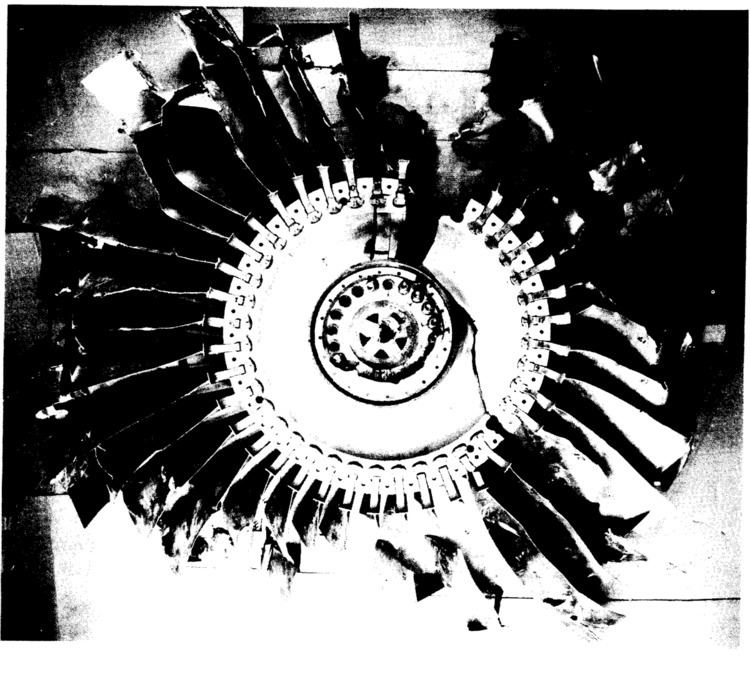 | ||
A turbine engine failure occurs when a turbine engine in an aircraft unexpectedly stops producing thrust or power production due to a malfunction other than fuel exhaustion, although the term "turbine engine failure" can also apply to failure of any turbine engine, such as ground based turbines used in power plants, turbine-engined vessels (i.e. CODAG) and vehicles, etc.
Contents
- Shut downs that are not engine failures
- Possible causes
- Failures during takeoff
- Failure during extended operations
- Contained and uncontained failures
- Notable uncontained engine failure incidents
- References
Turbine engines in use on today’s turbine-powered aircraft are reliable. Engines operate efficiently with regularly scheduled inspections and maintenance. These units can have lives ranging in the thousands of hours of operation. However, engine malfunctions or failures occasionally occur that require an engine to be shut down in flight. Since multi-engine airplanes are designed to fly with one engine inoperative and flight crews are trained to fly with one engine inoperative, the in-flight shutdown of an engine typically does not constitute a serious safety of flight issue. Following an engine shutdown, a precautionary landing is usually performed with airport fire and rescue equipment positioned near the runway. Once the airplane lands, fire department personnel assist with inspecting the airplane to ensure it is safe before it taxis to its parking position. Turboprop-powered aircraft and turboshaft-powered helicopters are also powered by turbine engines and are subject to engine failures for many similar reasons as jet-powered aircraft. In the case of an engine failure in a helicopter, it is often possible for the pilot to enter autorotation, using the unpowered rotor to slow the aircraft's descent and provide a measure of control, usually allowing for a safe emergency landing even without engine power.
Shut downs that are not engine failures
Most in-flight shutdowns are harmless and likely to go unnoticed by passengers. For example, it may be prudent for the flight crew to shut down an engine and perform a precautionary landing in the event of a low oil pressure or high oil temperature warning in the cockpit. However, passengers in a jet powered aircraft may become quite alarmed by other engine events such as a compressor surge — a malfunction that is typified by loud bangs and even flames from the engine’s inlet and tailpipe. A compressor surge is a disruption of the airflow through a gas turbine jet engine that can be caused by engine deterioration, a crosswind over the engine’s inlet, ingestion of foreign material, or an internal component failure such as a broken blade. While this situation can be alarming, the condition is momentary and not dangerous.
Other events that can happen with jet engines, such as a fuel control fault, can result in excess fuel in the engine’s combustor. This additional fuel can result in flames extending from the engine’s exhaust pipe. As alarming as this would appear, at no time is the engine itself actually on fire.
Also, the failure of certain components in the engine may result in a release of oil into bleed air that can cause an odor or oily mist in the cabin. This is known as a fume event. The dangers of fume events are the subject of debate in both aviation and medicine.
Possible causes
Engine failures can be caused by mechanical problems in the engine itself, such as damage to portions of the turbine or oil leaks, as well as damage outside the engine such as fuel pump problems or fuel contamination. A turbine engine failure can also be caused by entirely external factors, such as volcanic ash, bird strikes or weather conditions like precipitation or icing. Weather risks such as these can sometimes be countered through the usage of supplementary ignition or anti-icing systems.
Failures during takeoff
A turbine-powered aircraft's takeoff procedure is designed around ensuring that an engine failure will not endanger the flight. This is done by planning the takeoff around three critical V speeds, V1, VR and V2. V1 is the critical engine failure recognition speed, the speed at which a takeoff can be continued with an engine failure, and the speed at which stopping distance is no longer guaranteed in the event of a rejected takeoff. VR is the speed at which the nose is lifted off the runway, a process known as rotation. V2 is the single-engine safety speed, the single engine climb speed. The use of these speeds ensure that either sufficient thrust to continue the takeoff, or sufficient stopping distance to reject it will be available at all times.
Failure during extended operations
In order to allow twin-engined aircraft to fly longer routes that are over an hour from a suitable diversion airport, a set of rules known as ETOPS (Extended Twin-engine Operational Performance Standards) is used to ensure a twin turbine engine powered aircraft is able to safely arrive at a diversionary airport after an engine failure or shutdown, as well as to minimize the risk of a failure. ETOPS includes maintenance requirements, such as frequent and meticulously logged inspections and operation requirements such as flight crew training and ETOPS-specific procedures.
Contained and uncontained failures
Two terms are helpful in describing the nature of engine failures. A "contained" engine failure is one in which components might separate inside the engine but either remain within the engine’s cases or exit the engine through the tail pipe. This is a design feature of all engines and generally should not pose an immediate flight risk. An "uncontained" engine failure can be more serious because pieces from the engine exit the engine at high speeds in other directions, posing potential danger to the aircraft structure and persons within the plane. In the United States, the National Transportation Safety Board will likely investigate any uncontained engine failure involving a transport category aircraft.
